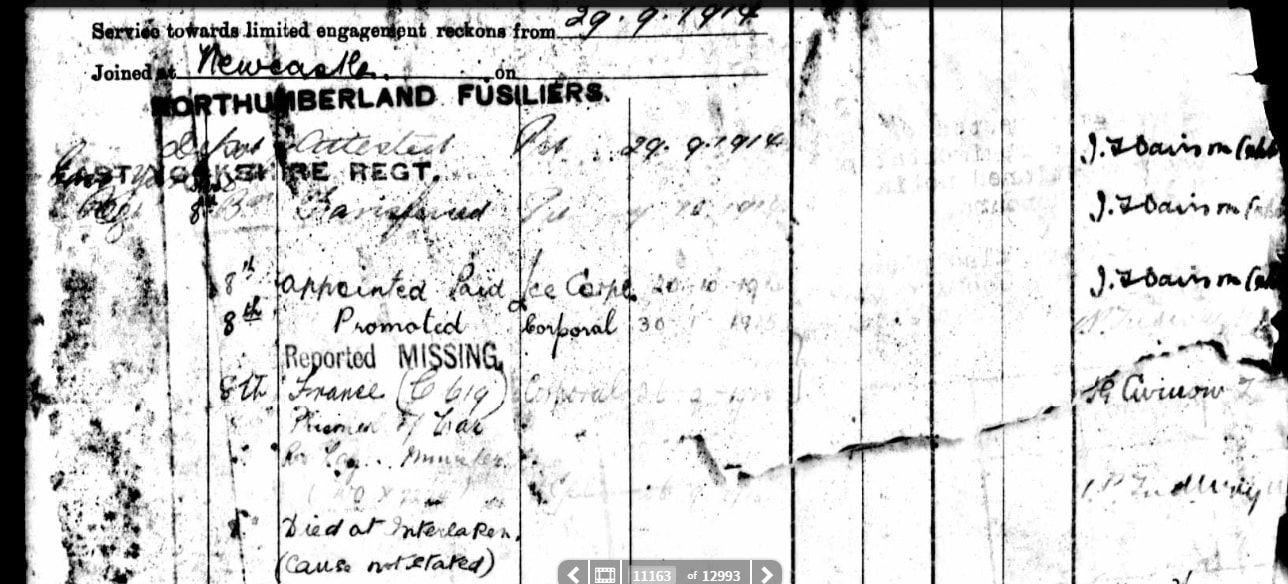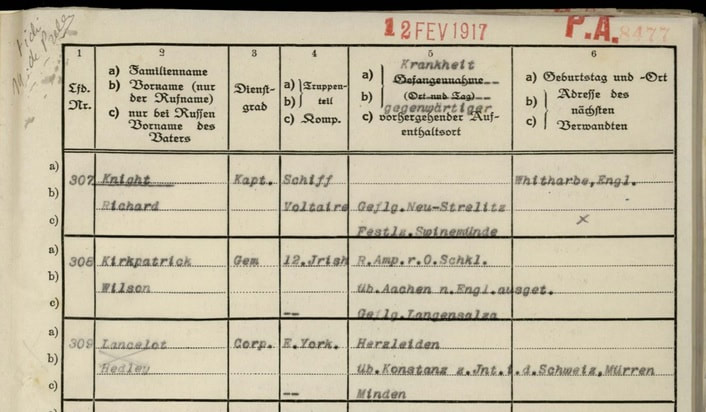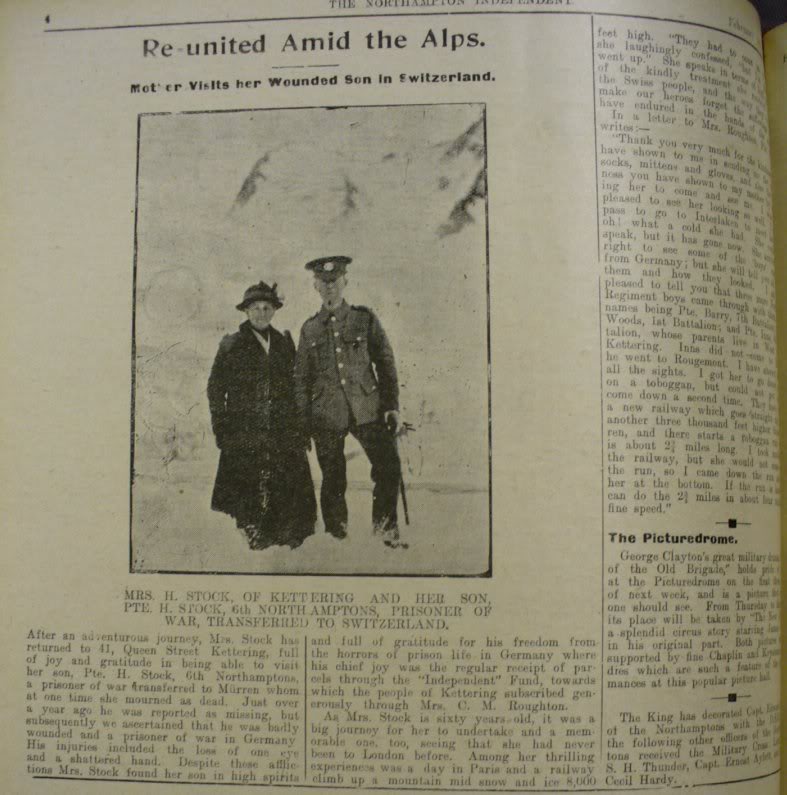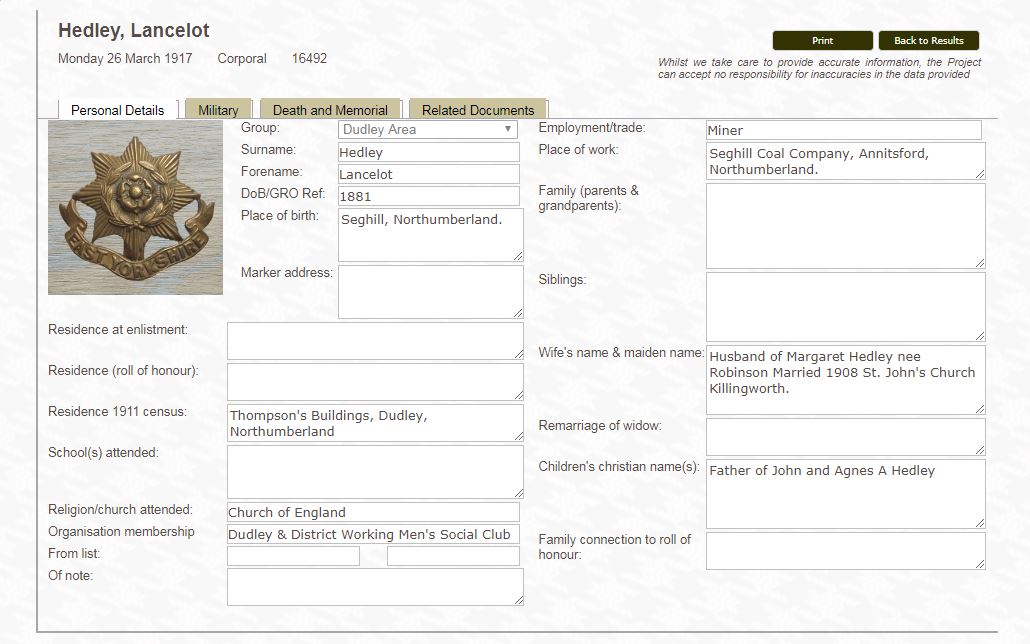|
As 2018 marks the centenary of the end of WW1, this months post is one that first appeared back in August 2015 in the 'Bitesize' section. It concerned a soldier by the name of Lancelot Hedley of Dudley who also formed a small part of the story of The Spowart Family of Backworth which appeared in September. I was contacted recently by Neil Hodgson whose research on behalf of the Northumbria World War One project has significantly enhanced what is known about Lancelot and his family. As the Easter holidays will afford many folks with the opportunity to dig into their family history it seemed a great opportunity to revisit some of the wonderful resources that are to help. Before explaining where they, and Lancelot's updated information can be found, below is a reminder of his story so far: LANCELOT HEDLEY - POW & SWISS INTERNEE OF WW1It is not every day that you get to spend the morning in the beautiful Swiss Alps. However, today was an exception as I was hot on the heels of a British POW by the name of Lancelot Hedley. What caught my eye was the date and place of death – 1917 in Switzerland. It is well known that the Country remained neutral for the entire duration of the conflict, so how had he come to be there? Lancelot was born in 1881, in Seghill near Morpeth in Northumberland and is a bit of a mystery man, as to date I have been unable to pin point his parentage, but it was believed he was the illegitimate son of a Jane Hedley. In the 1891 Census he is living with his grandparents John Hedley, a coal miner, and Ann Atherton his wife, at number 11 Chapel Row, Seghill, where there is no sign of his mother. Lancelot then proved a little hard to find in the 1901 Census but I believe I may have found him as a garden boy at Springbank Hall in Durham, before making his way North soon afterwards and before 1906 when he appears to have enlisted with the Tynemouth Royal Garrison Artillery, a territorial force, where his occupation is now listed as coal miner for the Seghill Coal Company. He was living at No 34 Jubilee Terrace, Annitsford (demolished in 1969). It must have been here that he met and married his wife Margaret Robinson, a Coal Miners daughter, in 1908. His full military service is a little difficult to put together as the documents that have survived are badly damaged. His discharge papers from the territorials were dated 1911 and at that time he had given five years and 102 days service. At the outbreak of hostilities in 1914, he initially enlisted with the Northumberland Fusiliers but was soon transferred to the East Yorkshire Regiment, where he reached the rank of corporal in January 1915. In September the same year he was reported missing in action with the 8th Brigade on active service in France. From his service record it would appear that he was initially held in POW camp at Münster. What happened next is little talked about or made reference to in the context of WW1 and the prisoners of war of both sides ~ and that is the means by which prisoner exchanges could be arranged, and repatriation effected through Switzerland. Below is a quote from http://www.switzerland1914-1918.net/prisoners-of-war-interned-in-switzerland.html an extremely informative site that goes into much more details than I am able to reproduce in this short article: “At the suggestion of the International Committee of the Red Cross (ICRC) and the Swiss government, Germany, France, Britain, Russia and Belgium signed an agreement in 1914 regarding prisoners of war (PoWs). The agreement stated that captured military and naval personnel who were too seriously wounded or sick to be able to continue in military service could be repatriated through Switzerland, with the assistance of the Swiss Red Cross. The first repatriations were made in March 1915, and by November 1916 some 8,700 French and 2,300 German soldiers had been repatriated” Lancelot Hedley fell into this category. His International Red Cross record shows that he was suffering from a ‘herzleiden’ or heart condition, severe enough to be eligible for the scheme in February 1917. He was transferred to Konstanz where he would have been medically assessed, before onward again to Mürren in Switzerland, where he sadly passed away due to “sickness” on the 26th March 1917. Having been transferred to Mürren he was no longer classified as a prisoner of war, but rather as an internee and still subject to military control, in this case the Swiss Army. The camp sat high in the Swiss Alps and during the harsh winter months was only accessible by cable car. However this did not deter visitors, and indeed many internees were reunited with their families whilst in residence thanks to the Red Cross. “Mothers and Wives were allowed to visit their menfolk in Switzerland and every few weeks under the direction of the Red Cross, a party of women would leave London for the Swiss camps”. As this heart-warming account bears testimony: Following his death, Lancelot was initially interred in Unterseen before being moved to the military cemetery that had been created at St Martins in Vevey. He is one of 66 British Soldiers who did not live to be repatriated and one of only 88 to pass away in Switzerland before 1923. Whilst I am not entirely sure this gentleman is the one and the same Lancelot Hedley who was living with his grandparents in 1891, I felt compelled to tell his story. It is so easy to focus on the horrors endured by the fighting men of WW1 so it is good to read and hear about the humanitarian aspects, brought about largely by the endeavours of the International Red Cross that saw many thousands of men from all the nations that had signed the original agreement in 1914, repatriated through Switzerland by the end of the War. Northumbria World War One ProjectThrough the endeavours of Neil Hodgson and another relative of the Hedley family, Lancelot's mother Jane has been traced, as have his children. However, I shall not spoil the story but rather encourage you to explore the fantastic interactive database on the website for yourselves. The project which began in 2015, covers the men of North Tyneside known to have been killed or died in military service, the Merchant Navy and fishing fleets during WW1. It is estimated by the time of its completion in Summer 2018 there will be in excess of 4,000 casualties entered in the database. Not only that, but the site encompasses the DOMINION GEORDIES, men of the North East who fought in the land forces of Australia, New Zealand, Newfoundland, and Canada, in which I found a pertinent record for another family case I am currently working on. Then, if that still isn't enough there are the GEORDIE DOUGHBOYS representing; 'the Hundreds of ‘GI Geordies’ (former natives of North East England) were among the American Expeditionary Force that came to Europe in 1917–18, Tyneside dockyards repaired and maintained US Navy ships operating in the Eastern Atlantic and North Atlantic, and in 1918 a US Aero Squadron was based in Newcastle. By researching the relationships that developed between individuals, communities, and industries in the North East and US armed forces, this project will help to foster understanding in the region of this historic aspect of the ‘special relationship’. Whilst this section does not feature an interactive database it does provide an interesting insight into America's role within the WW1 with particular emphasis again on the North East of England. There is also an impressive animated casualty map, plotting casualties, street by street, house by house, family by family and a blog packed with interesting stories and information. I think this is enough from me, I shall leave you to go and explore the website for yourselves! Remember too that if your ancestor was a Prisoner of War, their database which can be found at http://grandeguerre.icrc.org/. For other UK wide military records and covering many other conflicts Forces War Records is a great place to start. Plus this Easter weekend to celebrate 100 years since the formation of the RAF Forces War Records is offering you HALF PRICE membership off monthly and yearly packages. – less than £25.00 for the year, or less than £5.00 for a month* (use code EASTER50). Dont hang about though, as this offer expires on the 2nd April 2018!
0 Comments
|
AuthorSusie Douglas Archives
August 2022
Categories |
Copyright © 2013 Borders Ancestry
Borders Ancestry is registered with the Information Commissioner's Office No ZA226102 https://ico.org.uk. Read our Privacy Policy







